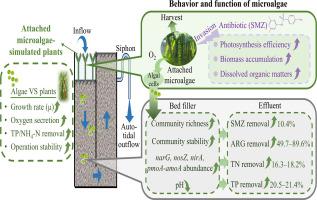Attached microalgae-simulated plants enhanced multiple-pollutant removal in a tidal flow constructed wetland: quantified efficiencies, pathways, and biological mechanisms
IF 12.4
1区 环境科学与生态学
Q1 ENGINEERING, ENVIRONMENTAL
引用次数: 0
Abstract
Active microalgae have great potential for releasing organic carbon and oxygen, which can be utilized as electron donors/acceptors, to enhance pollutant removal in constructed wetlands (CWs). In this study, we proposed a tidal flow CW with attached microalgae-simulated plants (AMSP) and verified the superiorities and mechanisms of microalgae's contribution to pollutant removal. The CWs with AMSP achieved high removal efficiencies for NH4![]() N (87.6 %), TN (62.7 %), TP (56.4 %), and COD (98.8 %), which were 45.7 %, 16.3 %, and 20.5 % higher for NH4
N (87.6 %), TN (62.7 %), TP (56.4 %), and COD (98.8 %), which were 45.7 %, 16.3 %, and 20.5 % higher for NH4![]() N, TN, and TP compared with those without AMSP. AMSP were found to enhance the abundance of functional microorganisms and genes involved in nitrogen metabolism, and to reduce the pH values in the bed filler to improve phosphate adsorption. Furthermore, the enhancement of NH4
N, TN, and TP compared with those without AMSP. AMSP were found to enhance the abundance of functional microorganisms and genes involved in nitrogen metabolism, and to reduce the pH values in the bed filler to improve phosphate adsorption. Furthermore, the enhancement of NH4![]() N and TP removal by AMSP was far beyond that of plants. Under the stress of 5 mg/L sulfamethazine (SMZ), the AMSP improved their photosynthetic efficiency and biomass accumulation, mitigated the impact of SMZ on the microbial community structure and diversity in the bed filler of CWs, increased the SMZ removal efficiency by 10.4 %, and reduced the release of antibiotics resistance genes into the environment by 49.7–89.6 %. These results demonstrated an effective integration of microalgal cultivation and CWs for treating wastewater containing emerging contaminants.
N and TP removal by AMSP was far beyond that of plants. Under the stress of 5 mg/L sulfamethazine (SMZ), the AMSP improved their photosynthetic efficiency and biomass accumulation, mitigated the impact of SMZ on the microbial community structure and diversity in the bed filler of CWs, increased the SMZ removal efficiency by 10.4 %, and reduced the release of antibiotics resistance genes into the environment by 49.7–89.6 %. These results demonstrated an effective integration of microalgal cultivation and CWs for treating wastewater containing emerging contaminants.


附着物微藻模拟植物增强潮汐人工湿地对多种污染物的去除:量化效率、途径和生物机制
活性微藻具有释放有机碳和氧的巨大潜力,可以作为电子供体/受体,增强人工湿地的污染物去除能力。本研究提出了一种附着微藻模拟植物(AMSP)的潮汐流连续水体,并验证了微藻对污染物去除的优势和机制。添加AMSP的CWs对NH4-N(87.6%)、TN(62.7%)、TP(56.4%)和COD(98.8%)的去除率较高,其中对NH4-N、TN和TP的去除率分别比未添加AMSP的CWs高45.7%、16.3%和20.5%。研究发现,AMSP可以提高氮代谢功能微生物和基因的丰度,降低床填料的pH值,提高磷酸盐的吸附。此外,AMSP对NH4-N和TP的去除效果远远超过植物。在5 mg/L磺胺甲基嗪(SMZ)胁迫下,AMSP提高了其光合效率和生物量积累,减轻了SMZ对CWs床填料微生物群落结构和多样性的影响,SMZ去除效率提高了10.4%,抗生素抗性基因释放到环境中的减少了49.7% ~ 89.6%。这些结果表明,微藻培养和化粪池的有效整合处理含有新出现的污染物的废水。
本文章由计算机程序翻译,如有差异,请以英文原文为准。
求助全文
约1分钟内获得全文
求助全文
来源期刊

Water Research
环境科学-工程:环境
CiteScore
20.80
自引率
9.40%
发文量
1307
审稿时长
38 days
期刊介绍:
Water Research, along with its open access companion journal Water Research X, serves as a platform for publishing original research papers covering various aspects of the science and technology related to the anthropogenic water cycle, water quality, and its management worldwide. The audience targeted by the journal comprises biologists, chemical engineers, chemists, civil engineers, environmental engineers, limnologists, and microbiologists. The scope of the journal include:
•Treatment processes for water and wastewaters (municipal, agricultural, industrial, and on-site treatment), including resource recovery and residuals management;
•Urban hydrology including sewer systems, stormwater management, and green infrastructure;
•Drinking water treatment and distribution;
•Potable and non-potable water reuse;
•Sanitation, public health, and risk assessment;
•Anaerobic digestion, solid and hazardous waste management, including source characterization and the effects and control of leachates and gaseous emissions;
•Contaminants (chemical, microbial, anthropogenic particles such as nanoparticles or microplastics) and related water quality sensing, monitoring, fate, and assessment;
•Anthropogenic impacts on inland, tidal, coastal and urban waters, focusing on surface and ground waters, and point and non-point sources of pollution;
•Environmental restoration, linked to surface water, groundwater and groundwater remediation;
•Analysis of the interfaces between sediments and water, and between water and atmosphere, focusing specifically on anthropogenic impacts;
•Mathematical modelling, systems analysis, machine learning, and beneficial use of big data related to the anthropogenic water cycle;
•Socio-economic, policy, and regulations studies.
 求助内容:
求助内容: 应助结果提醒方式:
应助结果提醒方式:


